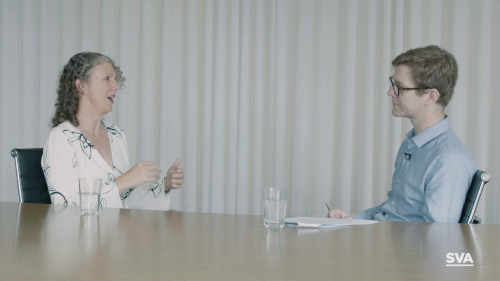
Outcomes contracting trailblazer shares knowledge – part 2
Part 2 of Elyse Sainty, director in the Impact Investing team and outcomes contracting advocate, sharing her insights after 10 years leading SVA’s work in social impact bonds (SIBs).

Patrick Flynn, director, public affairs, talks with Elyse Sainty, director, impact investing about what she has learnt after 10 years of developing social impact bonds.
Elyse reflects on the role of data and opportunities for data analysis that outcomes contracts provide.
She outlines the lessons learnt over the years and how state and federal governments can grow the benefits of this work.
She also covers what the future holds more broadly for outcomes contracting.
In part 1, Elyse, explains what SIBs are, reflects on the initial SIBs in Australia and explores why the various parties get involved.
Listen to the full conversation
Data and its uses
Patrick: Before you arrived at SVA you had worked as an actuary. What is an actuary or what is actuarial analysis?
Elyse: The skill set that you have as an actuary is grounded in a lot of statistics and analytics – actuaries are often found lurking in insurance companies and wealth management companies. Actuaries are good at understanding probability and projecting into the future.
One of the things I’ve enjoyed over the last decade is being able to go back to my roots with my actuarial training and apply some of that in this very different space. Simple skills like modelling, as well as being able to understand what could happen and how to make value judgments around those probabilities.
Patrick: How does that help us to solve social problems? And how do you use that set of skills to help construct some of these social impact bonds?
Elyse: The first thing I’d say is you don’t have to be an actuary to have the skills to construct social impact bonds. But it has been helpful for me and for others in this space to draw on an analytical approach, and to use big data to understand the problem.
And that starts with the fundamental question of ‘who are we trying to target with support, and what is going to happen to them if we don’t provide it?’ There have been a lot of advances in this space and social impact bonds have been a useful cattle prod, encouraging governments and other organisations to interrogate data to create that insight.
So the first part is: ‘where are there opportunities to fix things?’
And then the data is critical in understanding whether you’ve actually done anything useful in addressing the problem. How do you know what would have happened in the absence of the program? That critical question: ‘compared to what?’ is at the heart of an outcomes contract or a social impact bond because what you’re trying to measure is the change – and there’s money attached to that change in these contracts.
For more on this, listen to the podcast: 0:42-4:47Patrick: How can governments make the data accessible to service providers so that they can better understand the impact they are creating in the world?
Elyse: Firstly, figure out how you would use it. Think about the use case, and then think about what data is required, and then solve the technical bits about the piping: is it an Excel spreadsheet, or does it come through a dataset, how do we deal with the privacy issues and all those sorts of technical things.
“One of the key things that the service provider Vacro wanted was access to the data that tells them whether they’re making a difference.”
And start simple. There are so many programs that governments already spend millions and millions of dollars on where service providers would love to get their hands on the outcome data.
A classic case is our most recent project, the Arc Social Impact Bond in Victoria. One of the key things that the service provider Vacro wanted was access to the data that tells them whether they’re making a difference. They’ve been doing great work with people who’ve left prison, running a large program in the reintegration space, but they didn’t have access to the data to prove it, or to help them improve.
For more on this, listen to podcast: 16:41-21:44Patrick: For-purpose organisations are by definition driven by their purpose. Will just having a better understanding of how well they’re meeting that purpose drive a good set of behaviours?
Elyse: There is space for some experimentation where we test a hypothesis about where the benefit lies with outcomes contracting. For example, how much money needs to be at risk, or is the key thing having access to knowledge about whether you’re doing a good job or not, and having that transparently reported?
“… it’s the impact motive more than the profit motive.”
A lot of the response from the service providers is about knowing whether they did a good job and wanting to be better, not that sense of financial accountability and risk and return. I think it’s the impact motive more than the profit motive.
Patrick: Have we done enough work about understanding what kinds of contract drives a change in behaviour from service providers?
Elyse: There are two layers there. There’s the behavioural change at the service provider level. And then there’s also change at the commissioner level – that wise use of taxpayer money. So if governments are only paying for things that work, then maybe they’ll be more inclined to fund programs where they know that they’ve got that protection. There are two sides of the contract where you need to understand the motivations and the behaviour changes that are created, or needed.
What happened during Covid?
Patrick: Covid threw the whole world into a spin. It also threw SIBs into a spin. What happened to the SIB world through Covid?
Elyse: Yes there were lots of frantic negotiations and discussions. The first level of challenge was for the people we work with, we had to figure out how to deliver services and support individuals in very different ways. This created opportunities, but also meant that the work had to change rapidly and we were all worried about the impact of the pandemic on the beneficiaries that we were working with during that period.
“… we had to figure out how this massive disruption in the whole system changed all of those carefully calibrated assumptions…”
Then at the more esoteric contractual level, we had to figure out how this massive disruption in the whole system changed all of those carefully calibrated assumptions that created fair payments. We often had to make changes to terms at a contractual level to allow the work to continue.
A classic example is our Sticking Together Project SIB in NSW with SYC, which supports young people with barriers to employment into a job and helps them stick at work.
It was really hard to meet our hours in work targets in a context where everyone was sitting at home and there was suddenly this massive crisis in unemployment. Everyone involved brought a very collaborative approach to the question of ‘how do we figure this out together and make it fair?’
We ended up terminating the social impact bond financing and gave investors most of their money back, but the underlying program continued.
For more on this, listen to the podcast: 35:13-37:57How to get more from SIBs
Patrick: What’s your observation about how the central agencies and the line departments need to work together?
Elyse: They’re both critical. I think the New South Wales model where they created the Office for Social Impact Investment early on was really powerful because it does give you some continuity of technical knowledge about the contract structures and all the processes. If you’ve got the Treasurer behind a project that creates impetus as well. And that central agency can help to disseminate knowledge and create momentum.
“Sometimes it’s been best when there have been multiple departments involved.”
Sometimes it’s been best when there have been multiple departments involved. One of the things we’ve got to remember is that we’re trying to help people whose lives have challenges, and they often touch lots of different government departments.
So a good example would be our homelessness SIB with Hutt St Centre in South Australia. There was involvement and data that had to come from, and behind the scenes payments split amongst, three different departments: health, justice and homelessness services. Because people who are homeless are also high users of both the health system and the justice system.
This creates potential for a whole-of-government, human-centered view rather than a department based view. And so Treasury can sit in the middle of that and knit it together.
Patrick: Have you got any pearls of wisdom for governments about how they could use outcomes contracting to be more responsive to the needs of the people that they are seeking to serve?
Elyse: I know that that’s something that New South Wales is grappling with. They’ve now run multiple projects and are stepping back to learn: how do we, as a government, take that experience and think about what it tells us about, not just social impact bonds and outcomes contracts, but the way we commission more broadly – the way we think about policy and the way we run government.
Advice for governments
Do I have any pearls of wisdom? It does start with some of the data and that sense of thinking about the individuals behind the data. They’re not just consumers of health services for example, they’re actually people who have a journey through all of those different systems. Even just that is so powerful in forcing us to think about their journey, the touchpoints. And how do we streamline that and make sure that we’re treating someone as one person, not multiple consumers of product or services? And making sure they receive the support that will best help them.
There are some great people in our public service. So many of the people I work with are so passionate about doing a good job. They are still sometimes very constrained by the challenges and the complexities of the system that they’re in. It’s great when you bring people together in a shared project – it creates understanding, knowledge and can be a window into how things can be done collaboratively.
Patrick: Have we spent enough time trying to work out what that pathway is at the end?
Elyse: That’s a key question: how do you start with the end in mind, and it’s something that we should probably do more of. In the early contracts, we were more focused on the task at hand rather than the bigger picture. But now the bigger picture has to be much more front and center.
“… it was probably mostly a success because it helped to create more of the capability set for doing more contract work like this.”
So was Newpin a success? Yes, Newpin was a success. It helped a lot of families. The Newpin program is still running and it’s spawned a scale up through being deployed in other geographies as well. But it was probably mostly a success because it helped to create more of the capability set for doing more contract work like this.
However it did still feel like we got to the end and we were trying to retrofit ‘where does Newpin fit within the child protection system?’ It was more of a ‘now what?’, than a smooth transition to embedding, or a scale up in the broader landscape.
Patrick: What would you say to a Premier about the future of social impact bonds?
Elyse: Be intentional and learn from what’s been done, and understand how this work can be applied more broadly. I don’t mean by that necessarily more outcomes contracts or social impact bonds, but understanding or reflecting on what has been hard to date, and also what’s been good.
“Learn the right lessons from the work that’s been done.”
It’s almost more interesting to look at what’s hard and why, and then use this as the lab for improving the way government operates more generally. Learn the right lessons from the work that’s been done. In some instances it might be easy to look at some of the programs that have happened and go, ‘Oh, that was a lot of effort for one program.’
Why was it a lot of effort? What was the gap in the data, or what was the challenge in the legislation, or what was the challenge in the culture within both service providers and government and the way they interact, that meant that it was hard?
Patrick: Do you have a message for the Treasurer? Is it different from your message to the Premier because there is a slightly different role for the Commonwealth?
Elyse: It’s not a fundamentally different message, but there is so much scope for the Commonwealth to be useful in this space. It’s been great to see them start their own learning journey down this outcomes contracting path. They’ve got so much data; but it’s so hard to access. And because we’ve got the two levels of government, we have individuals who’ve got challenges that straddle cost centres in those two levels of government.
What the Commonwealth government could do
So collaboration between state-led initiatives with Commonwealth data and top up funding to make projects viable would massively increase the envelope of what’s possible in this space – what’s viable for state governments. The Commonwealth can play a bit of that role that we play in terms of being a knowledge carrier that can go around the various jurisdictions, but if the Commonwealth increases its knowledge and can share, and help standardise and make things more consistent around the country as well, that would be a massive assistance for everyone that’s doing this work.
Patrick: What’s the first thing that you would like them to do that they haven’t done yet?
Elyse: Figure out what the jigsaw puzzle looks like in the end. They’ve started to think about it, but it’s a hard question. What are all the pieces that we need to make this work and then be clear about which piece of the jigsaw puzzle they want to build at any time. You don’t have to build the whole puzzle all at once.
“It could be a 10 year journey before you get to the end picture.”
For example, how do privacy laws, regulations or contracting approaches help or hinder this work, and what do we need to do in relation to that? How do data linkage processes work? For example thinking about the interplay between the tax and the welfare data sets, and how they might they be useful.
It could be a 10 year journey before you get to the end picture. But if you understand what the jigsaw puzzle end picture looks like, then you can do a bit at a time and build to it.
Reflections on 10 years past and into the future
Patrick: Reflecting back on your 10 years plus with SVA. are there milestones or turning points that stand out for you from the decade?
Elyse: There have been so many milestones. Often they’re at a project level with all of the social impact bonds that we’ve worked with – I think of them as my children in a way, because they have this quite long gestation. Then they have their challenges as they grow up and eventually they leave the nest, and you hopefully see them flourish without you.
Every time we launch a SIB, or when there’s a major reporting milestone and we get some rich data and can share it, those milestones stand out because there is a shared sense of achievement with a group of people, within SVA but more broadly than SVA. I’m part of a lot of wonderful teams around the country.
Patrick: Are there things that you thought that we would have solved by now, 10 years on?
Elyse: I do think the data piece is frustrating; when we still don’t have baseline data supplied when a request for proposals comes out from government.
“If we don’t articulate or understand what we are trying to change, then trying to hang an outcomes contract off that is just guesswork.”
If we don’t articulate or understand what we are trying to change, then trying to hang an outcomes contract off that is just guesswork. We need to at least look at the baseline first. That’s one area that I thought we would have been better at by now.
Patrick: When we talked about the first couple of SIBs, they were $7 to $10 million, what about the $100 million SIB? What’s the ambition for the future of these kinds of transactions?
Elyse: Investors can get excited about the idea of $100 million SIBs. And it is a challenge because for larger, institutional investors, a $1 million investment is not worth their due diligence time, and understanding these quite complex contracts. So scale for the investment market would be very appealing and would turbocharge things.
What’s the ambition in scaling SIBs?
What I’ve come to realise though is that scale comes in many different forms. I don’t think scale in this space is large investment contracts, large social impact bonds. Scale is in the dissemination of the knowledge and changing the way work is done more broadly.
It can be difficult to run an individual program at a scale that creates a large bond off the back of it, because often you’re dealing with very specific populations and very specific work, and it’s very difficult to scale that up from zero to hundreds of millions of dollars of spend in a short space of time.
Our ambition now is to take a strategic approach to opportunities to evaluate an approach through something like a social impact bond, which then gives us insight into both the implementation challenges as well as the level of impact.
Then more good work can get done and it can shape the whole system.
Patrick: What would success look like for you 10 years into the future?
Elyse: Success would include having overcome some of the data challenges that we’ve talked about so that we can tap into sophisticated datasets easily and use that to find and design more, and more innovative, targeted and well-structured programs. And to know how they perform.
What would success look like in 10 years time?
Success would be that general government procurement has much more of a focus on feedback of results and insight back to both the individual service providers and the system more broadly. And that there’s more transparency, including an acknowledgment that things don’t always work, and that that’s okay because you have to try things to find out what works.
And stopping the things that aren’t working. Saving money on that, and spending more on the things that are working. A lot of this isn’t related to social impact bonds specifically, it’s the progeny of social impact bond work, and the way it feeds back into broader system design at a government level, and of practice at a service provider level.
Patrick: What’s heartened you the most over this period of time about the work in this space?
Elyse: Seeing it work, and being able to go from anecdote to data. So seeing it work at the level where we get these wonderful insights into how a program can change people’s lives on the ground – that’s always fantastic. That’s the stuff that really warms your heart, But it doesn’t necessarily persuade ministers to change policy, and doesn’t change the way programs are run.
“Having sound evaluations and outcomes data gives you the clout to go with the human side of what’s happening.”
Having sound evaluations and outcomes data gives you the clout to go with the human side of what’s happening. So that’s been really heartening. And it gives me a sense that good work won’t go to waste, that good work will lead to more good work in the future.
Listen to the podcast Read part 1
Contributors: Elyse Sainty and Patrick Flynn
Elyse has passed the baton to Kirsten Armstrong, who has joined SVA in the role of Director Impact Investing to continue our outcomes contracting and Social Impact Bond work.








